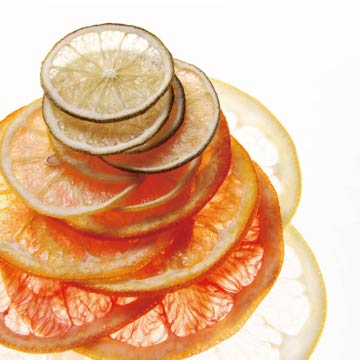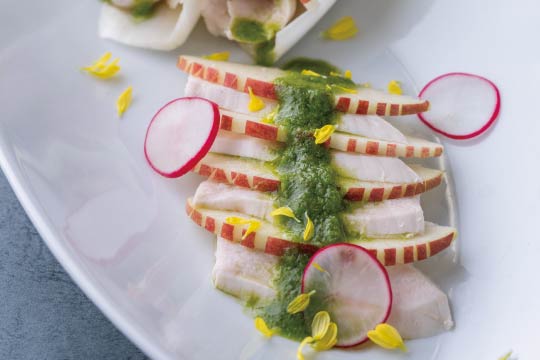News & Blogs
This is how Chef Tamura first learned about TREHA®.
Chef Tamura's favorite benefits of TREHA®.
Chef Tamura explains his dish: Cold chicken and apple slices drizzled with scallion and Sichuan pepper jade sauce. (jiāo má jī piàn)
In this blog, we touch on diverse topics about Japanese food cultures, practices together with the culinary secret, TREHA®, and its important role in the Japanese food industry. We hope our blog helps you obtain in-depth knowledge of the secrets and science behind Japanese cuisine, shared from our kitchen, to yours.
Today, we would like to present an interview with Chef Tamura, a renowned Japanese chef in Chinese cuisine. He is the owner-chef of Itsuka (慈華) in Tokyo. The restaurant was rated "1 Star" by Michelin Guide and "3 toques" by Gault & Millau. The interview took place on September 5th, 2019.
How did you first learn about TREHA®? What made you start using it?
I was intrigued by TREHA® when I saw it featured in a professional magazine for French chefs. I wanted to know what it is and why professionals use it for their cuisine.
I ordered TREHA® just out of curiosity and tried it to prepare marinated salmon sashimi, following the bits of advice from a French chef I had known. Since I usually use salt and granulated sugar to marinate salmon, I tied replacing granulated sugar with TREHA®. Although I liked the low sweetness of TREHA®, I did not find many advantages other than that. After a while, I learned about the multi-functionalities of TREHA® and then seriously got involved with deepening my knowledge.
Which raw materials do you use TREHA® for? What are your favorite functions of TREHA®?
I use TREHA® pretty much for every dish every day. The more I know about TREHA®, the more I develop new ideas about using it. Now I realize many valuable functionalities of TREHA®. My most favorite function is moisture retention for meat. Braised Pork Belly (Dong Po Rou/ dōng pō ròu) retains a tender and moist texture without shrinkage, including the meat touching the bone. After 2.5-3 hours of cooking, the fatty part of the pork belly becomes super tender, but the lean part tends to be dry. The texture significantly improves when I coat the pork with 2% TREHA® of its weight, let it stand for a day, and then cook in the broth, including 2% TREHA. Even when I pay close attention to the temperature control during cooking, the result is not as great as when I use TREHA®. Now TREHA® is one of the indispensable ingredients in my kitchen.
Another element the moisture retention comes in very handy is spring roll fillings. Water content seeped from fillings would cause rupture, and the surface would discolor during deep-frying. I resolved this by increasing potato starch in the fillings, which resulted in a stiff texture. Adding 2% of TREHA® allowed me to cut the amount of potato starch by half. I successfully achieved the melt-in-mouth consistency. Not to mention, reduced rupture is a big plus for the work efficiency. I make the fillings ahead in a batch, which lasts for three days, and wrap the spring roll shells right before the restaurant opens. Water release from the fillings is barely recognizable on the third-day mark.
Now I plan to use “fruit chips” containing TREHA® to garnish my appetizers and desserts. I have been a fan of using fruit chips because they enhance a dimension in a dish, but the challenging part is that they quickly become soggy. When I visited the NAGASE office, a manufacturer and supplier of TREHA, I learned how to make fruit chips by soaking in a 40-50% TREHA® solution. Even after a few days, the fruit chips maintained crispiness, much longer than conventional fruit chips made only with sugar. I thought there was no way not to take advantage of this functionality.

Have you witnessed TREHA® extending shelf-life and any considerable cost advantage from it by reducing waste?
The shelf-life of scallion sauce has been extended – now, I can maintain the freshness for a week in a refrigerator. Although I don’t have to manage large-scale preparation due to the size of my operation, TREHA® contributes to improving work efficiency daily by keeping the fresh color and reducing water release from the ingredients.
Would you explain your creation, "Cold Chicken and Apple Slices with Scallion and Sichuan Pepper (jiāo má jī piàn) Jade sauce"?

Gently boiled chicken with scallion jade sauce is one of the traditional Chinese cuisines. Sichuan pepper gives an accent to the jade sauce drizzled over the chicken. Since fruits often become part of Sichuan cuisine’s main dish, I created a colorful dish using seasonal apples cut into decorative shapes of phoenix wings.
TREHA® suppresses protein denaturation and retains moisture in boiled chicken.
Chicken breast tends to become hard due to its uneven thickness. The thin part tends to dry out when the thick part cooks through. However, 2% TREHA® in boiling water makes whole chicken breast soft and juicy.
TREHA® retains the natural color of scallion jade sauce with Sichuan pepper.
Jade sauce maintains its bright color because it is an oil-based sauce; however, it exhibits an even more brilliant green color when made with TREHA®. The bright color lasts even after week-long storage in a refrigerator. TREHA® helped me to prepare the traditional sauce with an enhanced appearance.
TREHA® retains the natural color of apple slices and keeps a fresh texture.
I am reluctant to soak apple slices in salt water because it adds saltiness to the apple surface. The TREHA® solution, on the other hand, does not either sweeten the apples or impact the taste due to the low sweetness.
TREHA® maintains the fresh texture of fresh-cut radish.
The dish calls very thin sliced radish. Delicate edges of sliced radish would polish the overall creation. The radish surface is freshly maintained by soaking in 3% TREHA® solution for 10 minutes.
Did you find this blog interesting?
Please share it with your friends in the food service industry.
We regularly update the blog about the food culture of Japan, where TREHA® was discovered for culinary applications.
Click here and send us a message to subscribe.
Or hit us up on Instagram @trehalose_sensei!
You might also be interested in the following interview articles:
Chef Shimomura, the executive chef of a MICHELIN Plate Japanese cuisine restaurant in Yokohama
Chef BAE, the Chocolate prize winner at the Coupe du Monde de la Pâtisserie 2017


